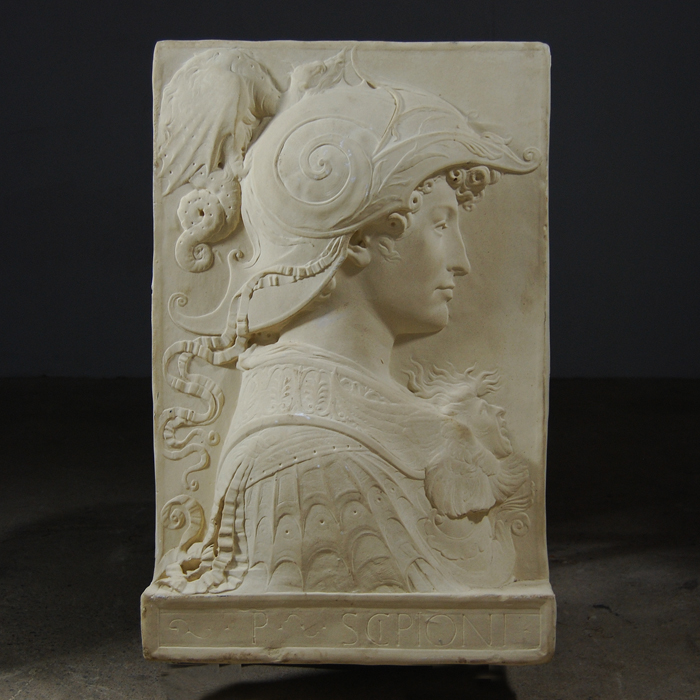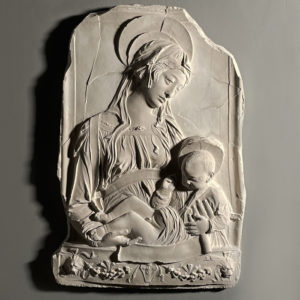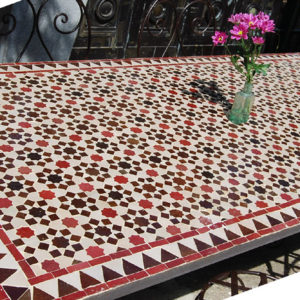A cast plaster relief of Scipio Africanus
the general depicted in fantastical armour in profile,
£350
Publius Cornelius Scipio Africanus (236–183 BC), was a Roman general and later consul who is often regarded as one of the greatest military commanders and strategists of all time. His main achievements were during the Second Punic War where he is best known for defeating Hannibal at the final battle of the Battle of Zama in 202 BC, one of the feats that earned him the agnomen Africanus.
Prior to this battle (near modern Zama, Tunisia) Scipio also conquered Carthaginian Iberia, culminating in the Battle of Ilipa (near Alcalá del Río, Spain) in 206 BC against Hannibal's brother Mago Barca.
Although considered a hero by the general Roman populace, primarily for his contributions in the struggle against the Carthaginians, Scipio was reviled by other patricians of his day. In his later years, he was tried for bribery and treason, unfounded charges that were only meant to discredit him before the public. Disillusioned by the ingratitude of his peers, Scipio left Rome and withdrew from public life.
The sculptor Andrea del Verrocchio:
Little accurate biographical information is known about Verrocchio. He was the son of Michele di Francesco Cioni, a maker of bricks and tiles who later became a tax collector. Financial security always seemed to be a family problem. Verrocchio had to support several of his brothers and sisters. Never marrying, he later provided for the education and dowries of the daughters of his younger brother Tommaso.
Initially he was trained as a goldsmith. His master has traditionally been recorded as a supposed goldsmith, Giuliano Verrocchi, whose last nameAndrea apparently took as his own.
Verrocchio’s most important works were executed in the last two decades of his life. His rise to artistic prominence, which he owed chiefly to encouragement by Piero de’ Medici and his son Lorenzo, the leading art patrons of Florence, evidently began only after the death, in 1466, of Donatello, who had been the Medici favourite. Besides the paintings and sculptures Verrocchio produced for the Medici, he designed costumes and decorative armour for their festivals, tournaments, and solemn receptions. Made curator of the collection of antiquities in the Medici palace, he restored many pieces of ancient Roman sculpture, especially portrait busts.
It appears that Verrocchio produced few works for patrons outside of Florence. Though he is said to have worked in Rome for Pope Sixtus IV, among others, there is no documentary trace that he ever left the area around Florence until the early 1480s, when he moved to Venice, where he died within a few years. Even while he was in Venice his Florentine workshop was maintained and directed by his favourite student, Lorenzo di Credi. Di Credi was also the administrator and principal heir of Verrocchio’s estate.
Verrocchio’s reputation was widespread in the second half of the 15th century and many well-known artists of the Italian Renaissance studied painting and sculpture at his Florentine studio. The most important of his students were Leonardo da Vinci and Perugino, the latter Raphael’s teacher.
The only surviving painting that according to documentary proof should be by Verrocchio, an altarpiece of the Madonna and Child with Saints in the Donato de’ Medici Chapel of the cathedral at Pistoia, was not completed by the master himself. Largely executed by his pupil Lorenzo di Credi some is thought to be painted by his apprentice, the young Leonardo da Vinci. After the mid-1470s Verrocchio dedicated himself principally to sculpture, in which he manifested strong personal convictions and an inventive ability.
The sculptural works either recorded to be by Verrocchio or actually extant are few in number.
Verrocchio’s earliest surviving example of figurative sculpture is a small bronze statue of David, which is generally dated before 1476. A second bronze figure, the Putto with Dolphin, is important in the development of freestanding Renaissance sculpture for its spiral design, which represents a successful effort to evolve a pose in which all views are of equal significance. It was originally commissioned for a fountain in the Medici villa in Careggi, near Florence. The putto is precisely balanced in the projection of its limbs and probably was placed initially on a fountain so that it could be turned by the pressure of streams or jets of water. In the mid-16th century it was reinstalled on top of a fountain designed for the courtyard of the Palazzo Vecchio in Florence (the original is now kept in the Palazzo Vecchio museum; the present fountain figure is a copy).
His reputation as one of the great relief sculptors of the 15th century was clearly established with his cenotaph, or memorial, in the cathedral at Pistoia, to a Tuscan ecclesiastical dignitary, Niccolò Cardinal Forteguerri. Ordered in 1476, the cenotaph was still unfinished when Verrocchio died, and its completion was entrusted first to Lorenzo di Credi, then others.



